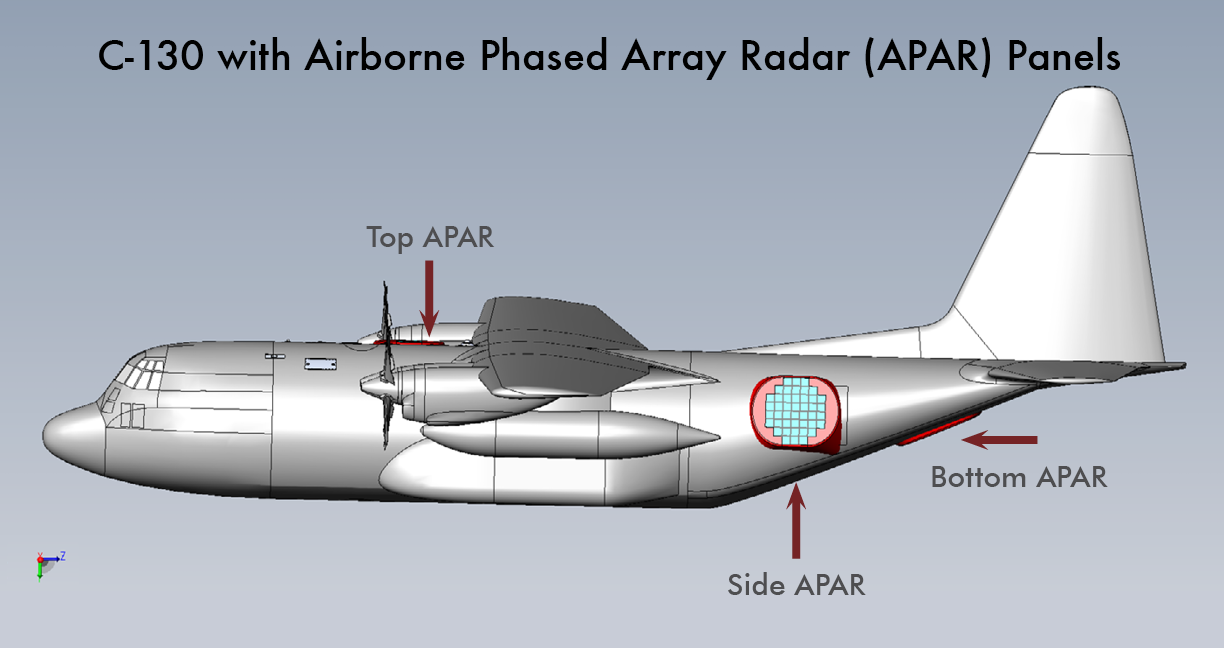I. DESCRIPTION
Airborne radars are the most effective instruments available for observing storms over complex terrain, oceans, Polar Regions, and forested areas that are not readily discernible by ground-based radars (Bluestein and Wakimoto, 2003). Airborne, fast-scanning Doppler radars provide high-resolution, three-dimensional (3-D) wind fields as the aircraft flies past a storm. By adding dual-polarization capability, an airborne radar can also provide microphysical information, such as particle type (ice or water) and characteristics (e.g., hail, graupel, snow crystals, liquid/ice water contents). This makes an airborne weather radar the ideal observational platform to study atmospheric phenomena involving clouds and precipitation in hard-to-reach areas. However, the dual-polarization capability cannot be upgraded from the existing airborne tail Doppler radar (TDR) antenna configuration currently used on the NOAA airborne fleet.
At present, only new electronically-scanned multiple antennae Phased Array Radar (PAR) technology can concurrently provide microphysical information and 3-D winds. Therefore, to fill the critical need in the community for fast scanning airborne Doppler polarimetric radar, the Earth Observing Laboratory (EOL) of NCAR proposes to design, fabricate, and operate an Airborne Phased Array Radar (APAR) to fly on the NSF/NCAR C-130 aircraft. The NSF/NCAR C-130 is the ideal platform for APAR as it is unique in its ability to meet the heavy-lift and long-duration flight requirements necessary to house the radar as well as other complementary measurement tools. The airborne radar observations that are readily available at present do not have the spatial resolution or the polarimetric capability that are necessary for either advancing understanding of high-impact weather events or assimilation into high-resolution numerical weather prediction models. Once developed, APAR will be available to the research community for 20-25 years through the well-established request process for NSF’s Lower Atmosphere Observing Facilities (LAOF). An airborne radar such as APAR will also directly support NOAA’s long-term Mission Goal of developing America’s capabilities as a “weather-ready” nation and will directly address NOAA’s strategic objective of providing improved understanding and timely alerting of severe and adverse weather events.
II. DEVELOPMENT STATUS
Over the past three years, APAR has completed several critical milestones in the APAR development. These include:
2016:
- Completion of an APAR Conceptual Design.
- Completion of an APAR Technical Requirements Document (TRD)
- Completion of Computational Fluid Dynamics (CFD) airflow study of APAR on the NSF/NCAR C-130.
- Completion of an RFI with industry to evaluate the feasibility of developing the Active Electrically Scanning Arrays (AESA) and other Radar Front End hardware.
2017:
- Completion of the APAR Master Project Management Plan (MP2).
- Building and testing of 2X8 Line Replaceable Unit (LRU).
- NCAR/EOL was awarded $2.3M from NOAA for the Airborne Phased Array Radar Development and Risk Mitigation Project. This project included four tasks:
- APAR Trade Studies: To examine the technical specifications versus cost tradeoffs in building the AESAs resulting in an improved set of technical requirements.
- LRU Development: The design and implementation of the LRU demonstrator will allow EOL to develop and test several of the important elements of the final APAR system from both a hardware and software perspective. Integration of these elements will reveal potential design challenges.
- NSF/NCAR C-130 Vibration Testing: Vibration testing to understand the vibration characteristics of the platform and, in turn, how the vibration may affect APAR performance.
- APAR Observing Simulator Prototype (AOS): Produce synthetic radar output from numerical weather prediction models that will result in the development of optimal flight patterns and scan strategies for APAR.
- Completion of Ground Vibration Testing (GVT) on the NSF/NCAR C-130.
- Completion of Flight Vibration Testing (FVT) on the NSF/NCAR C-130.
- State-of-the-art airborne radar, with unique capabilities and specialized observing instruments available to the nation's weather researchers via the NSF/NCAR C-130 aircraft.
- The ability to significantly improve our understanding of storm dynamics as well as raindrop and ice crystal characteristics, leading to better estimates of storm strength, heavy precipitation, and their potential impacts.
- An adaptable design for the C-130 and potentially other aircraft operated by many agencies in the United States and other nations, including the U.S. Air Force, for hurricane reconnaissance and research.
- Penetrating deeper into storms, allowing research aircraft to fly at a safer distance from severe weather while obtaining vital data.
- Tropical cyclones (hurricane genesis, track, intensity change, landfall location, and impacts)
- Severe weather (tornadoes, supercells, squall lines, derechos, etc.)
- Mountain-related precipitation and flooding
- Winter storms and fronts (blizzards, ice storms, etc.)
- Oceanic weather (showers and thunderstorms)
- Climate processes that connect the ocean and atmosphere (El Niño, La Niña, etc.)
